Report

Introduction
Brazil is the world’s largest beef exporter by volume, leading a market that is expected to grow by 35% over the next two decades. With its vast territory, favorable climate, and strong cattle ranching culture, Brazil is poised to serve a growing share of the global market.
But as pressure mounts for food producers to follow more sustainable practices, Brazil’s worsening reputation on the environment looms large over the industry’s future. Expansion of cattle ranching (traditionally associated with carbon emissions) must incorporate more sustainable practices in the Brazilian Amazon and Cerrado, where deforestation rates are increasing again after years of decline.
Written in collaboration with
Written in collaboration with

So even as global population growth and broader income distribution create new opportunities for Brazil’s meat industry, changes in consumer preferences, investors’ demands for accountability, and a greater focus on food security impose new challenges.
To face these challenges and spur a cycle of economic growth, Brazil’s beef industry must increase transparency across the supply chain, offering better visibility into the origins of its cattle and, most important, ensuring that production is not linked to deforestation. A deforestation and conversion-free (DCF) business model for Brazil’s cattle industry is not only financially and technically feasible from a land-use perspective, but will also create greater value for companies, ranchers and investors compared with the wasteful approach of forest clearing and the associated risks.
The main candidates to lead this effort are Brazil’s three largest meat-packers, which together account for around 35% of the country’s beef production and about 85% of beef exports. Of course, this enormous effort must have the committed support of other stakeholders, including government, retailers, restaurants, investors, lenders, the leather industry and consumers. Only through a coordinated effort of the key players in the value chain can Brazil’s meat industry ensure deforestation-free production and continue to grow as a global leader in beef exports.
Agribusiness: the workhorse of Brazil’s economy
Brazil’s agribusiness industry has been a major driver of the country’s economy. While Brazil’s GDP rose a mere 1.1% in 2019, agriculture grew 3.81%—accounting for around 21% of the country’s total output. The beef industry, including retail and other associated sectors, is one of the main pillars of Brazil’s agribusiness sector, making up 8.5% of the country’s GDP in 2019.
And there is room for growth. According to data from the Food and Agriculture Organization of the United Nations and the US Food and Drug Administration, global demand for animal protein is expected to rise by a third over the next 20 years—with Brazil potentially supplying almost half of that growth. With a cattle herd of approximately 232 million head and almost 20% of its production destined for foreign markets, Brazil’s beef exports grew by almost 17% from 2018 to 2019, according to the Brazilian Beef Exporters Association—a trend that is likely to continue, even as importing countries shift their shares. For example, China’s share of Brazil’s total beef exports grew to almost 50% by May 2020, from 35% in 2019.
The problem of low-value beef exports
Brazil’s beef exports go mostly to countries that buy lower-value-added products—at the same time receiving lower-than-average prices in those same markets (see Figure 1). Around 80% of the country’s beef exports are raw (“in natura”) meat and live animals, with China, Hong Kong and Egypt—the three largest buyers—importing more than half of the meat shipped by Brazil. This market emphasis on low-value-added exports, rather than higher-value and processed products, exerts pressure on margins, leaving little room for investments in productivity and sustainability.
Among the main importers of Brazilian meat, Hong Kong and Singapore pay the highest prices for global beef exports, even though the price paid for the Brazilian meat is below their average and even below other low-value-added importers such as the Philippines, Russia and China. Brazil is starting to position itself for higher prices in Europe, where Brazilian meat sold for 40% below the EU-28 average price in 2016, according to Comtrade Database. Since then, prices have risen somewhat, although traded volumes are still low. Countries in the European Union also demand greater transparency, requiring all calves to be traceable before reaching 10 months of age, and ensuring that meat comes from EU-approved regions and farms.
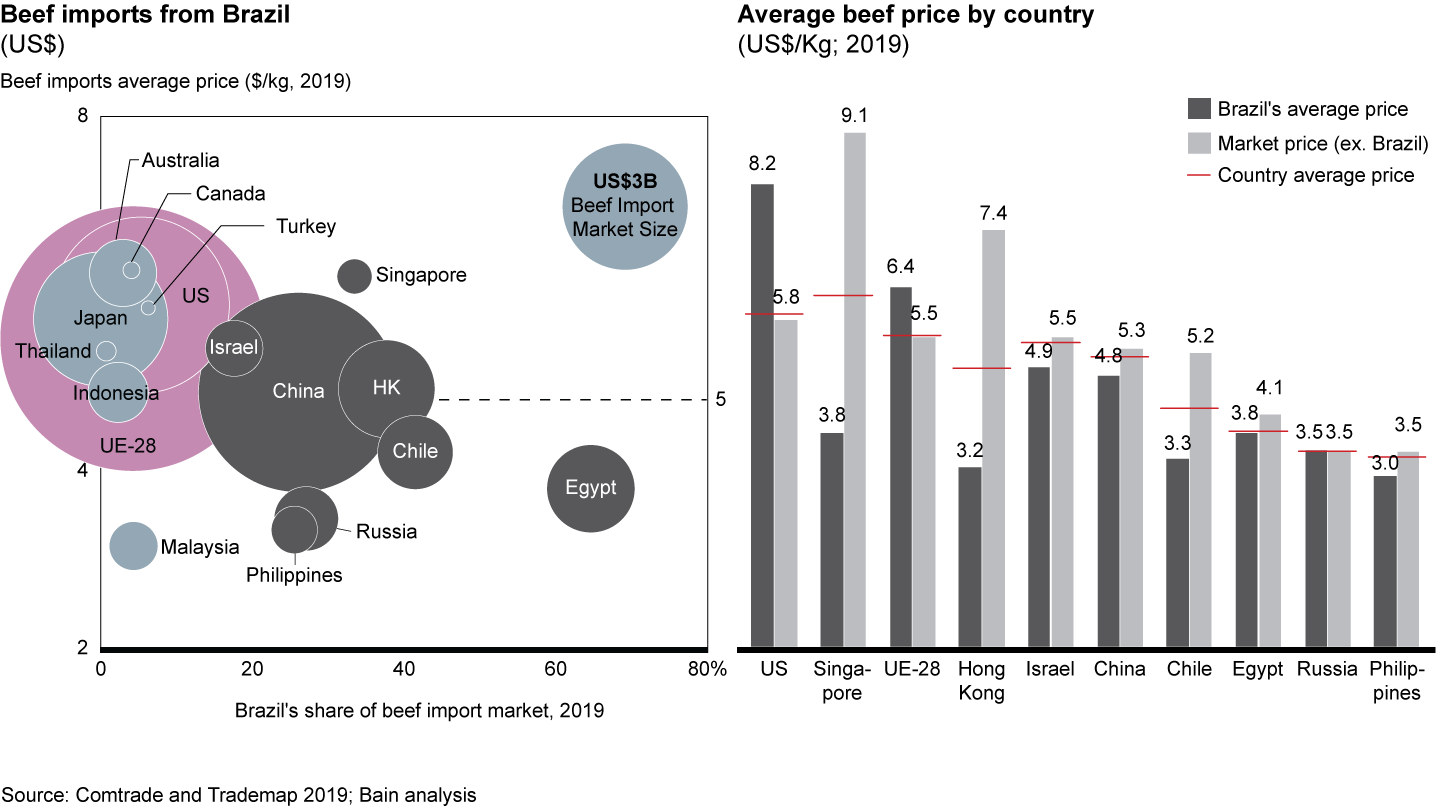

Low productivity, more deforestation
While home to the world’s largest commercial cattle herd, Brazil lags the US and other countries in cattle-raising productivity. One major culprit is the extensive cattle ranching system still prevalent in Brazil: Low-tech operations that invest little in land and pasture care, or in animal husbandry, account for about 90% of the country’s production, according to IEG FNP Agribusiness. Without proper management, pastures lose their nutrients, reducing cattle productivity. Of the country’s 180 million hectares covered by pasture, the state-owned Brazilian Agricultural Resarch Corporation, Embrapa, estimates that more than half is in some stage of degradation. In the absence of continuous efforts to prevent degradation—such as integrating cattle farming with agricultural crops, controlling the stocking rate (the number of animals per grazing area), engaging in regular analysis and correction of soil fertility, controlling weeds and pests, and rotating animals to allow pastures time to recover—pastures can lose their capacity to feed animals in only three or four years.
That explains Brazil’s average stocking cattle rate of 1 animal unit per hectare (AU/ha), according to ScienceDirect, with an average productivity of 65 kilograms per hectare per year. Although the rate has improved in recent years (surpassing the EU average of 0.8 AU/ha in 2016), it still trails countries like the Netherlands, where the stocking rate is 3.8 AU/ha, almost four times the Brazilian average.
With sustainable intensification, many Brazilian producers have raised their stocking rate from 1 AU/ha to 4 AU/ha (depending on the biome), while productivity has grown even more. With better genetics, more sustainable practices, improved soil and animal welfare, and easier access to water, cattle grow faster—and younger cattle generate higher-quality beef and less carbon dioxide per kilogram of beef, leading to higher returns for producers.
While the expansion of cattle farming is propelling economic growth in Brazil, it is also a huge threat to the Amazon and Cerrado biomes, due to its historical link to deforestation (see Figure 2). Some cases of deforestation, both in the Cerrado and the Amazon, occur in tandem with efforts to open new areas for cattle raising. A Bain analysis shows that in the Brazilian state of Mato Grosso, around 40% of deforested areas can be associated with cattle ranching. The study also showed that the number of producers associated with deforestation is small, as 10% of cattle producers account for 60% of deforestation linked to cattle production.
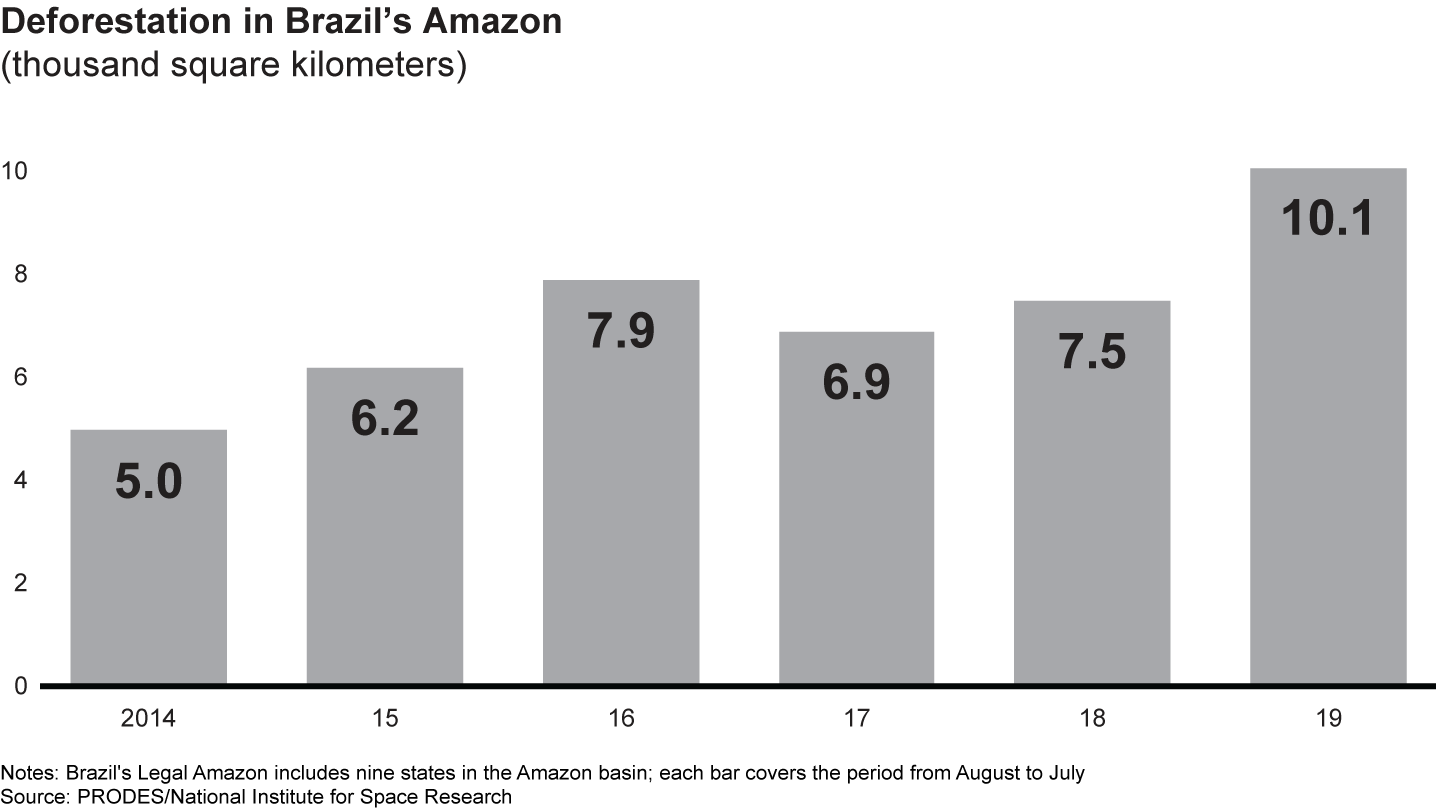

In recent years, the pace of deforestation in Brazil has accelerated. From August 2018 to July 2019, a total of 10,100 square kilometers of forest were cleared, a 34.4% jump from the year before and the steepest increase in more than two decades. The trend continues in 2020: the amount of tree cover slashed from January to April was 55% greater than during the same period in 2019, according to data from the National Institute for Space Research.
Unless Brazil’s beef industry can transition from low-productivity, extensive ranching to more sustainable and intensified ranching, the need to increase production to meet rising demand will be addressed by expanding the area for raising cattle. Inadequate soil management and low productivity will inevitably lead to more deforestation.
New practices in cattle production
The transition to a sustainable model follows the good ranching practices established by Embrapa back in 2002. In addition to technical assistance to break the vicious cycle of low productivity methods, the transition requires capital expenditures in soil recovery, genetics, fencing for pasture subdivision and water supply, as well as working capital for cattle acquisition and soil maintenance.
Most capital expenditure loans for agriculture require repayment terms over five to seven years, but most cattle ranchers in Brazil cannot access this kind of financing. To help break this cycle, The Nature Conservancy has been working on ways to reduce lenders’ risk and unlock long-term credit lines reserved for low-carbon agriculture. One example is a 20% first-loss guarantee to banks willing to lend to DCF sustainable ranching intensification, backed by an investment fund whose thesis incorporates restoration and preservation of tropical forests. These and other efforts can reduce risks enough so that bankers can lend to sustainability efforts while still meeting their financial goals.
The shift to deforestation-free cattle ranching will require a sustainability perspective, generating positive chain reactions in the environmental, social and corporate governance (ESG) dimensions, as well as access to long-term financing by ranchers. In a hypothetical scenario, good soil management on a farm that integrates crops, livestock and forest will prevent pasture degradation. This would help the soil to recover, reduce the environmental damage from cattle ranching and lower the pressure to clear more forest.
How can the Brazilian cattle industry promote the development of cattle farming and boost its major role in the economy without contributing to legal or illegal deforestation in both the Amazon and the Cerrado biomes? The answer to that question depends on new preferences and perspectives of both consumers and investors worldwide, as well as production methods adopted by ranchers.
Investors’ focus on sustainability
Calls for sustainability are coming from multiple fronts—including investors and consumers who are increasingly focused on environmental sustainability. According to a study by Fundação Getulio Vargas, an education and research institution, more than a quarter of the Brazilian population says it has completely changed buying habits due to environmental concerns (see Figure 3). In richer countries, this trend is even stronger.
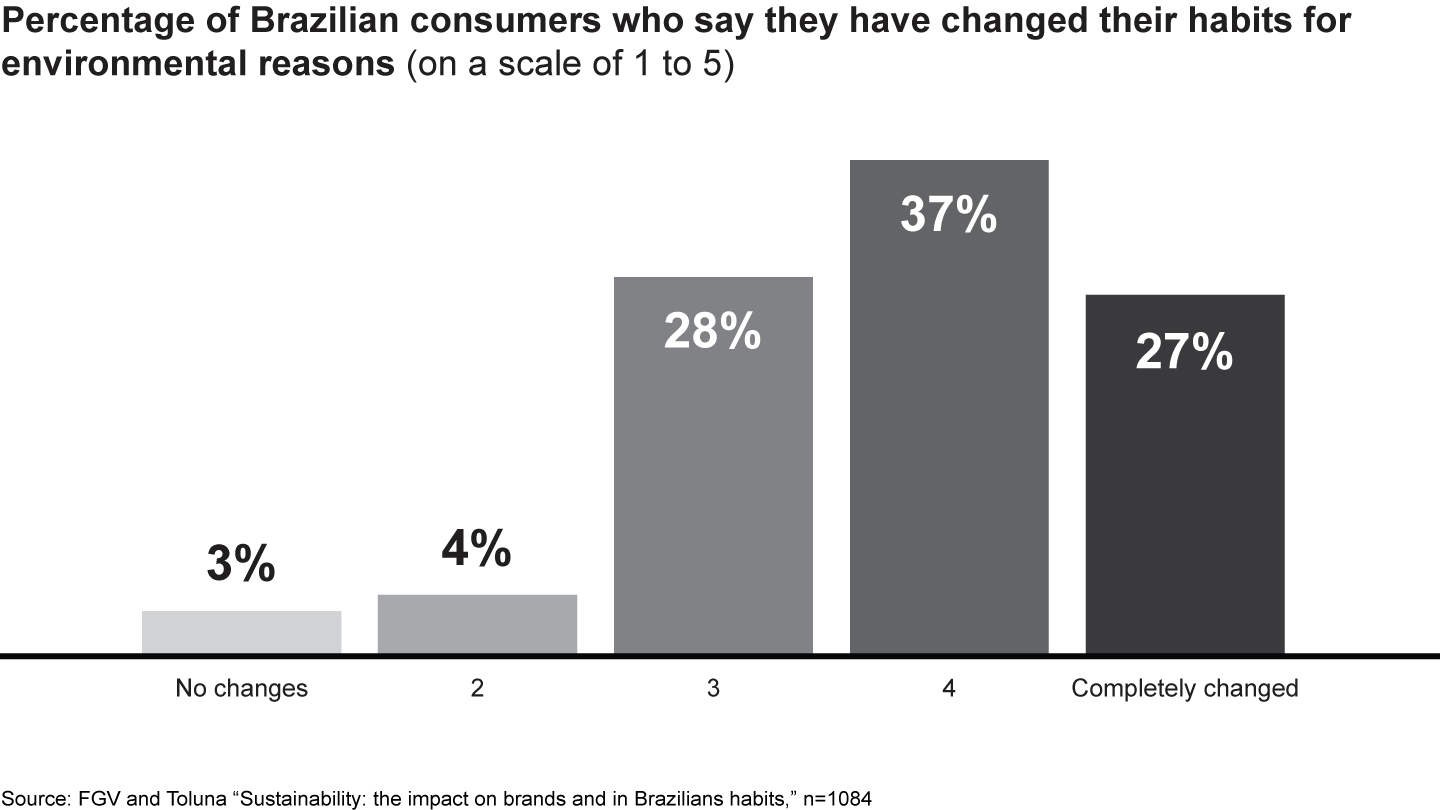

Institutional investors are adjusting their portfolios to reflect environmentally related risks, including deforestation, and sustainable portfolios are expected to provide better risk-adjusted returns over the long run. In addition, shareholders will continue to push for higher corporate transparency, avoiding investments associated with these risks. For example, in July 2020, Nordea Asset Management, the investment management arm of Finnish financial firm Nordea, dropped one Brazilian meat-packer from its portfolio due to its environmental record.
As the pressure to adopt more sustainable practices mounts, the global volume of assets managed by impact-investing funds—private equity and venture capital funds that invest in companies to encourage positive social and environmental activity—has quadrupled from 2009 to 2019, to $28 billion.
This trend reflects a deeper transformation toward sustainable investment in global finance. In his annual letter to CEOs in January 2020, BlackRock CEO Larry Fink wrote that climate risk is investment risk, and that business leaders and investors should be guided by the goal of creating gains for all of its stakeholders. And in June 2020, a group of 29 organizations managing a combined $3.7 trillion in assets sent an open letter to the Brazilian government expressing concern over the “increasing deforestation in Brazil” and warning of “widespread uncertainty about the conditions for investing” in the country. The letter stated that protecting biodiversity and tropical forests are in the best long-term interests of their beneficiaries, implying the reputational risk of failing to take action to guard against deforestation.
Meat processors must lead
To take advantage of this favorable moment and gain share in the global market for meat products, Brazil must develop a more transparent supply chain, one that ensures that its products are not contributing to deforestation. Developing a more transparent supply chain will be a complex endeavor, requiring collaboration among all stakeholders in the beef and leather value chains, along with crucial support from government agencies. Without this support, deforestation caused by cattle farming is unlikely to decline.
Meat processors, because of their access to data from cattle producers, are in an ideal position to play a key role as they work with suppliers to establish a supply chain free of deforestation. Three large processors (JBS, Marfrig and Minerva) lead the market; the rest of the market is more fragmented, adding complexity and making engagement a more challenging task. Brazil’s meat industry features complex business relationships, sometimes marked by distrust. Margins remain tight, which may create a starting point to engage businesses in this effort. To stem declining profitability, the industry will need to improve quality along with environmental, social and governance standards (see Figure 4). In fact, studies indicate that adapting a deforestation-free business model creates value for companies, ranchers and investors across the entire value chain, compared with the business-as-usual approach of continued forest clearing, with its associated risks. (For more, see the Harvard Business Review article “How to Quantify Sustainability’s Impact on Your Bottom Line.”)
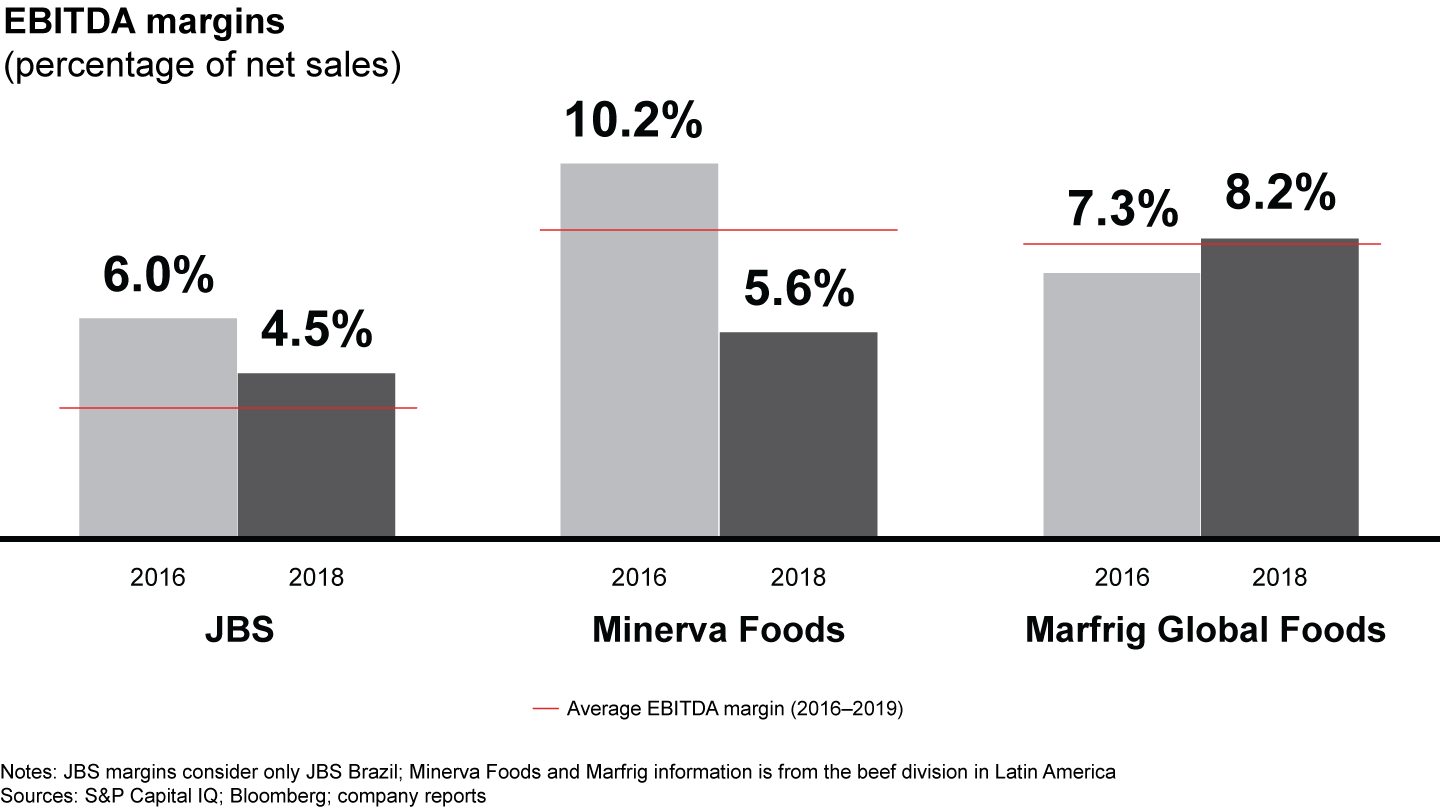

Support from three pillars of industry
In recent years, some Brazilian meat-packers have increased their commitment to supplier visibility. In 2009, JBS, Marfrig and Minerva signed an agreement (Compromisso Público da Pecuária) to refuse cattle from any farms directly involved in deforestation of the Amazon, but clearly more needs to be done. This past June, Marfrig launched an action plan to guarantee that 100% of its production chain (including indirect suppliers) is sustainable and deforestation-free by 2030.
No single actor in the value chain can develop a comprehensive solution. A robust solution will require motivating a broad collection of stakeholders, making sure their interests align in order to gain traction. Three main pillars of the cattle industry—leather, beef, and investors and lenders—will need to work together to create lasting change (see Figure 5).
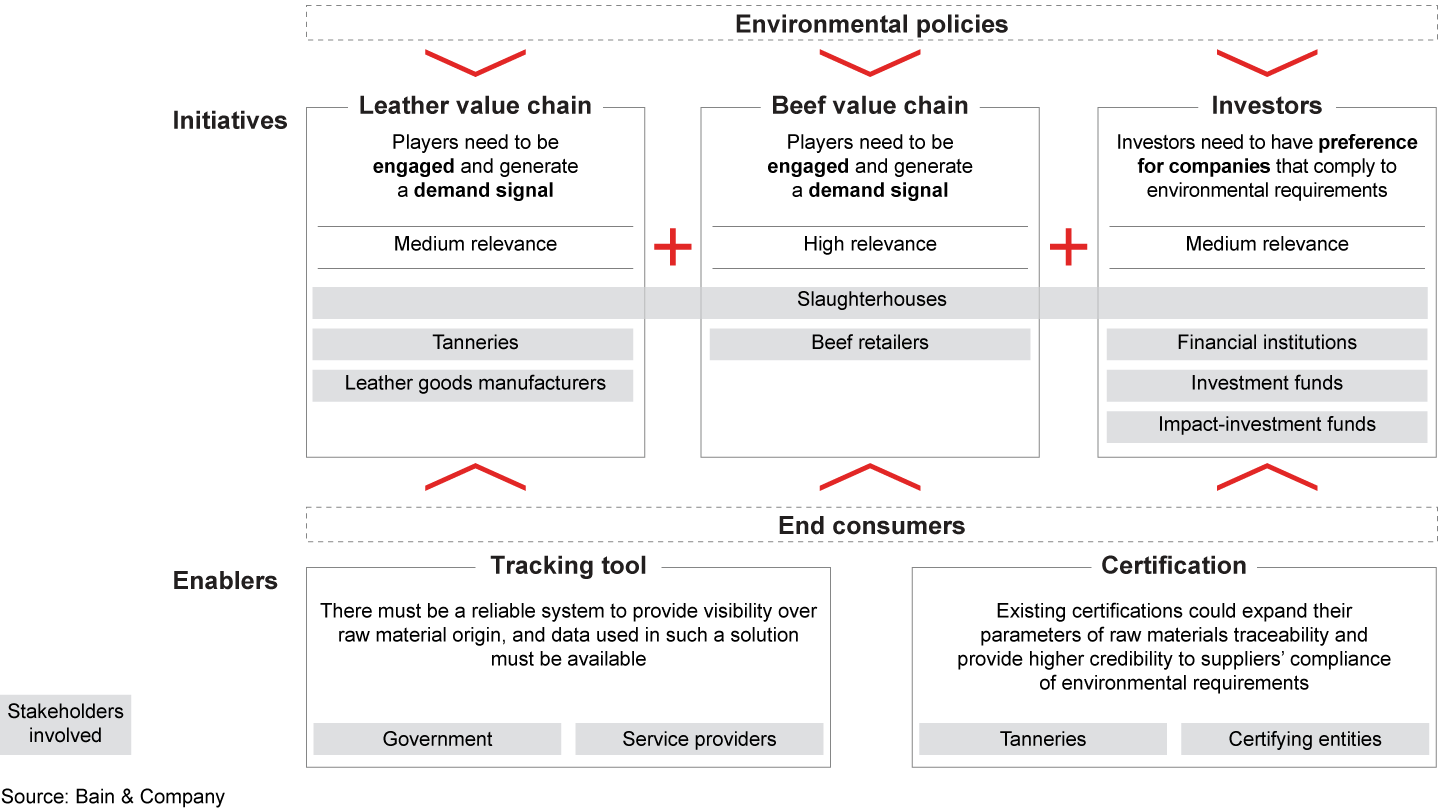

Leather. While meat plays a central role in the livestock value chain, several by-products are also important, especially leather, which can account for up to 26% of the big slaughterhouses’ earnings. Brazil’s $3 billion leather industry is the third largest, after only Italy and the US. It generates 40,000 direct jobs in Brazil, with 310 tanning plants, 2,800 suppliers of components for both the leather and shoe industries, and 120 machinery and equipment manufacturers.
However, the global leather industry is under increasing pressure as customers in the automotive, fashion and furniture industries seek out lower-cost, synthetic alternatives, sourced primarily from petroleum. Since 2014, the value of global leather exports has fallen by 30%, and the value of Brazil’s leather exports has fallen by half, given its dependence on lower-value products.
The large manufacturers of leather goods, particularly those that cater to customers demanding more sustainable products, could play a significant role in the shift to greater transparency. By establishing partnerships with tanneries and slaughterhouses to enhance transparency over the origins of raw materials and making sure the final customer gets a high-quality, deforestation-free product, these manufacturers could gain a competitive advantage. Major brands exert great influence in raising consumer awareness about supply chain transparency and its link to preventing deforestation. For example, VF Corporation, a US company that owns Timberland and other brands, said in 2019 it would stop buying Brazilian leather in the wake of the Amazon fires. Efforts by automakers are especially important, particularly in Brazil, where the auto industry is the final destination for about one-third of all domestic leather production, and half of all leather coming out of the top three players (see Figure 6). Brazil’s auto market is relatively consolidated and consists mostly of large brands operating within global markets, which are often more demanding and committed to sustainability issues.
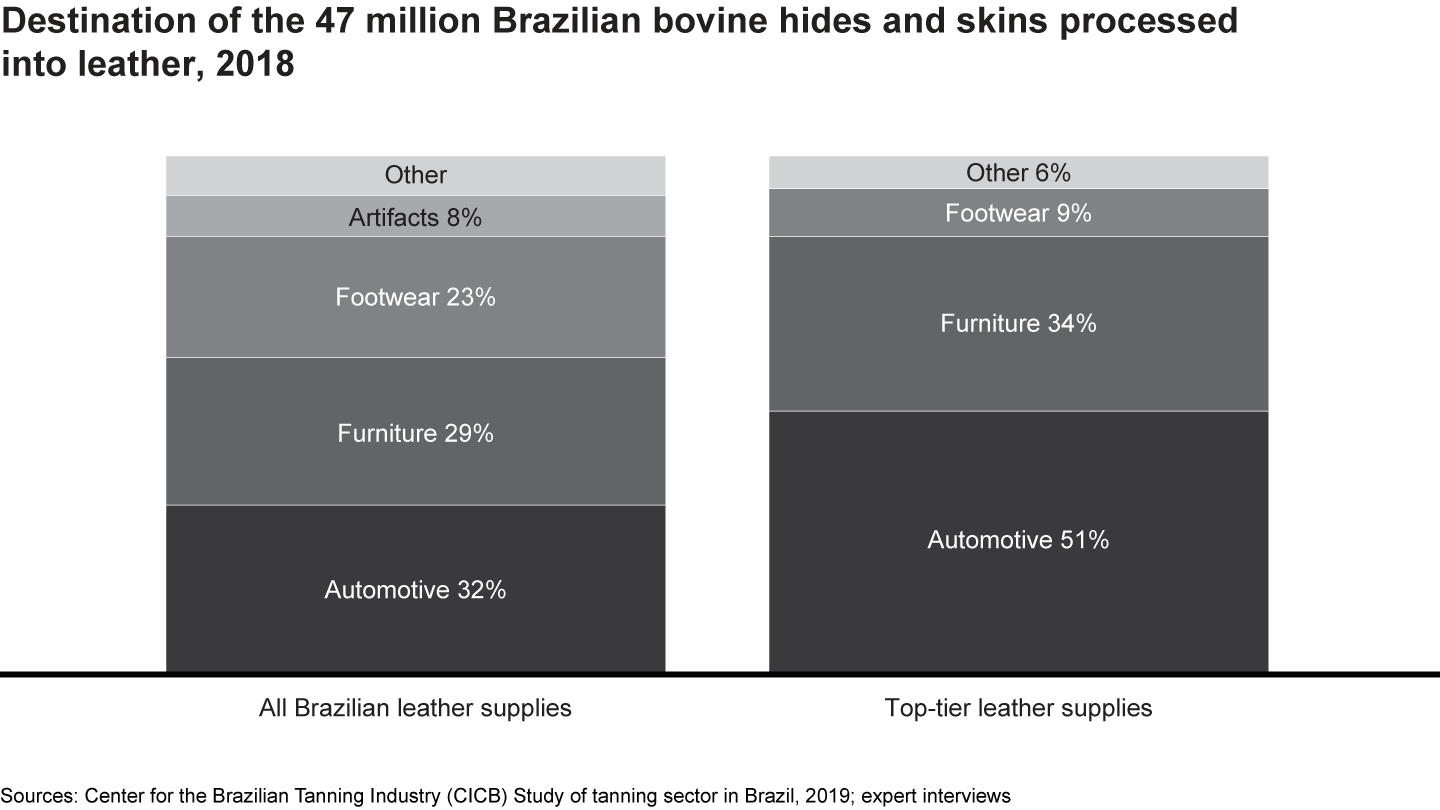

Beef. Meat-packers can already trace the origins of their supply using a few available tools, but most of these fail to reach the level of indirect suppliers, where much of the deforestation occurs. The livestock production chain is complex and can involve multiple intermediaries throughout the three stages of animal raising and fattening (see Figure 7).
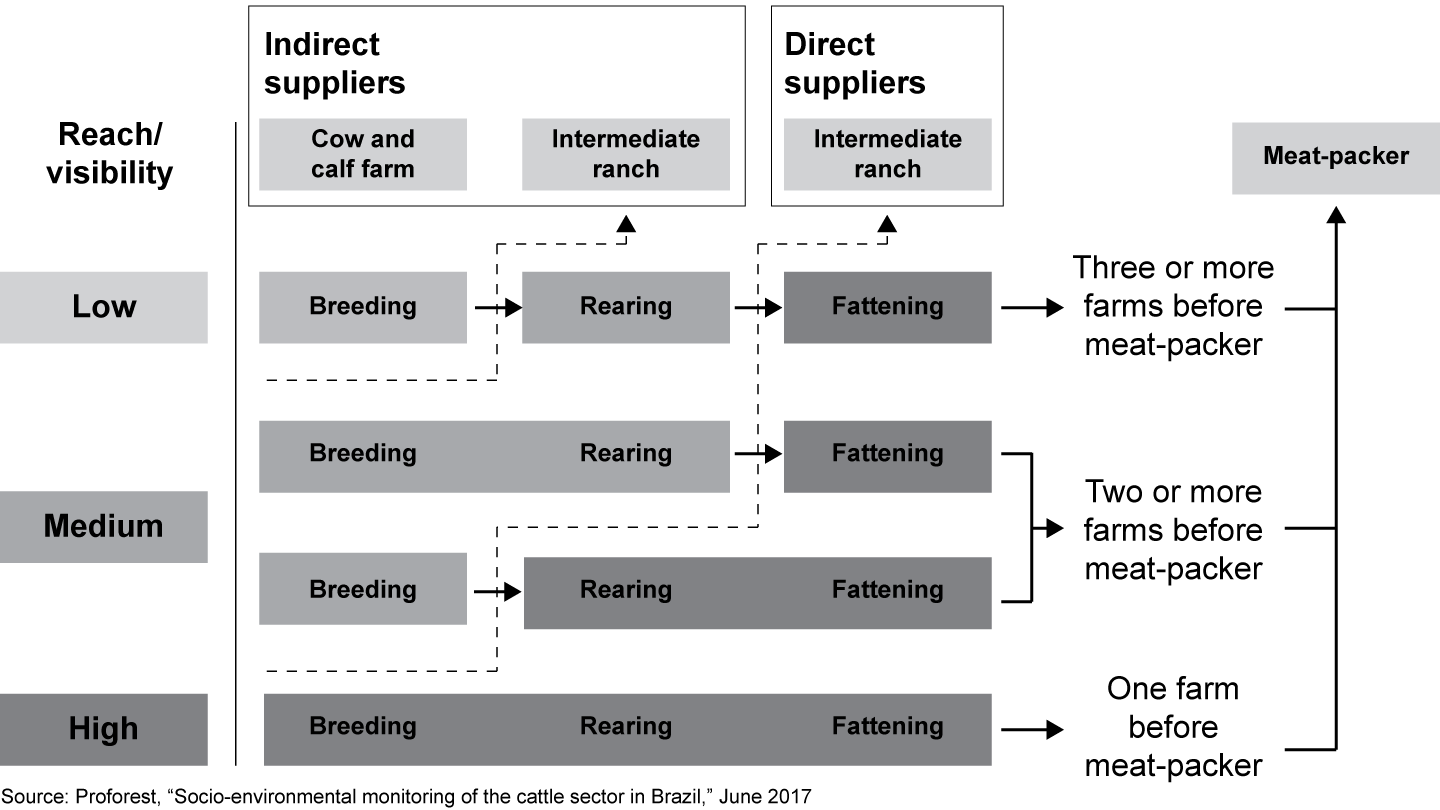

However, Brazil needs a more comprehensive system to track the entire meat supply chain, and the good news is that the relevant data already exists within several systems used by the government. A methodical compilation of data from Animal Transit Permits, the Rural Environmental Registry for rural property boundaries, and deforestation-monitoring data from PRODES—all public information databases—could become a powerful tool for providing visibility over the entire value chain. For this to happen, the Brazilian government must participate.
Support from the beef industry’s customers will also be vital, including large retailers, small and midsized grocery stores, restaurants and butcher shops (see Figure 8). Of these, the large supermarket chains will be key change agents in establishing strategic alliances with meat-packers and creating transparency in the supply chain. It will be to their benefit, as consumers are demanding better quality and more information about the origins of their food. Moreover, ensuring a supply of beef untainted by deforestation or habitat conversion helps differentiate the quality of their products. Building these alliances could also foster more trust in supply chain relationships and distribute economic returns more equitably, while also addressing investors’ need for greater social responsibility.
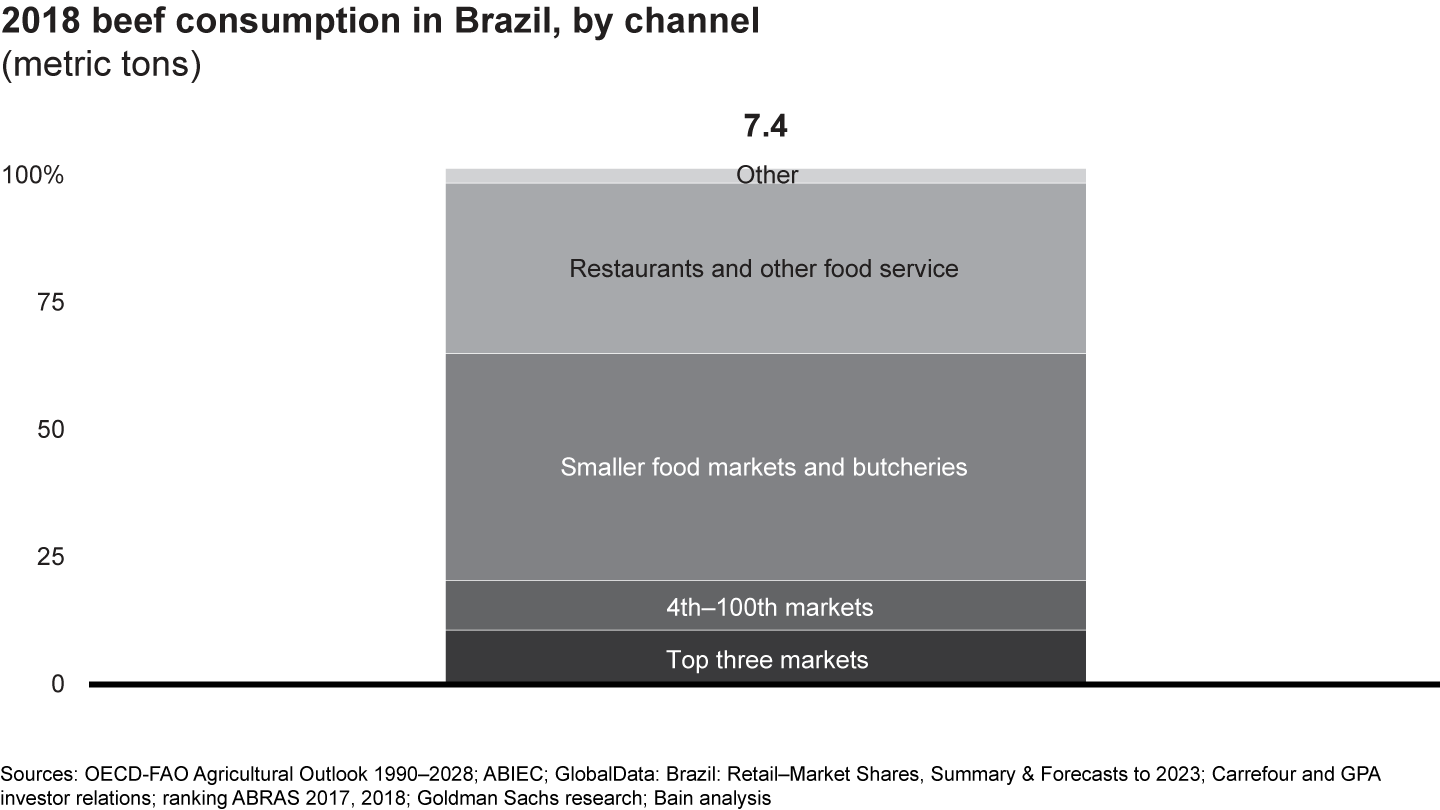

Some efforts are already underway:
- In 2010, the Carrefour Group made a global commitment to zero deforestation, an initiative that, in Brazil, started to guide all meat purchases from local suppliers.
- In 2016, Grupo Pão de Açúcar announced guidelines to achieve 100% transparency on the direct origin of both fresh and frozen beef sold in its stores—including the decision to summarily ban all suppliers who refused to collaborate with the program.
- France, home of retailers Casino and Carrefour, has announced that by 2030, it will ban all imports from regions experiencing deforestation issues.
- In addition, the French Duty of Vigilance law establishes a legal obligation for companies to identify and prevent environmental impacts resulting from their own activities, from activities of companies they control, as well as subcontractors and suppliers with whom they have an established commercial relationship.
In spite of these efforts, deforestation persists, suggesting that risks for retailers will also endure.
Investors and lenders. Those who finance the meat producing industry will play a critical role in pushing the industry toward a DCF business model. In a study for The Nature Conservancy, Bain concluded that meat processors that fail to keep up with new developments related to sustainability—including, crucially, traceability—may eventually be considered higher-risk investments. They would be subject to higher risk premiums in debt and equity markets. As part of this study, simulations showed that the increasing cost of debt could, over time, depress meat-packers’ net earnings by 3% to 7%—which is significant, given the industry’s margin levels. From the equity perspective, higher risk premiums could reduce valuations as much as 30%.
Meat-packers should proactively engage investors and funds as they define their sustainability policies, offering transparency and reassurance that they are adopting practices that can protect the environment and communities, and so can avoid suffering the consequences of a global trend of divestment from businesses associated with deforestation.
Transitioning Brazil’s cattle ranches to a business model free from deforestation and habitat conversion is a complex task that will require the coordinated effort of many stakeholders across a value chain held together in fragile relationships. As the central figures in this chain, as well as the participants with some of the most significant international business and financial relationships, the large meat-packing companies must play a leading role in this transition. Investors, retailers, leather customers and government agencies will also need to play key roles, as will the cattle ranchers themselves, who must be supported in their efforts at the front lines. But the benefits are worth pursuing: Brazil stands to gain economic as well as environmental benefits if it can produce beef and leather free from the taint of deforestation and habitat conversion.
Written in collaboration with
Written in collaboration with

About The Nature Conservancy
The Nature Conservancy is a global conservation organization dedicated to conserving the lands and waters on which all life depends. Guided by science, we create innovative, on-the ground solutions to our world’s toughest challenges so that nature and people can thrive together. We are tackling climate change, conserving lands, waters and oceans at an unprecedented scale, providing food and water sustainably and helping make cities more sustainable. Working in 79 countries and territories, we use a collaborative approach that engages local communities, governments, the private sector, and other partners. To learn more, visit www.nature.org.